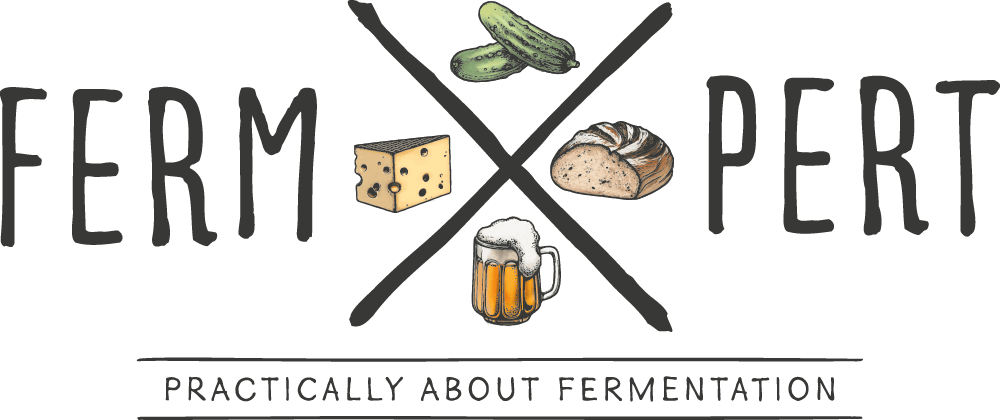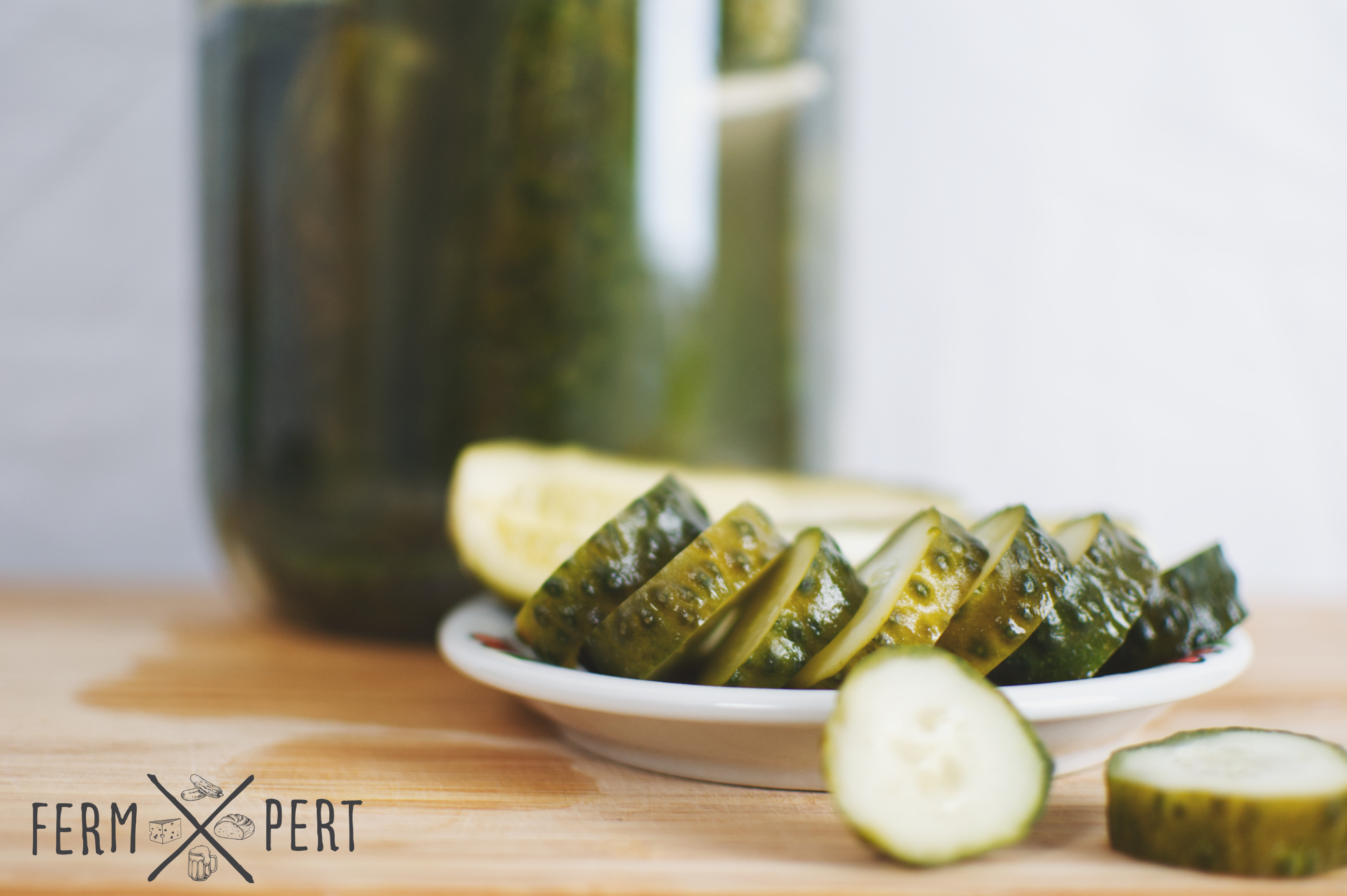Pickling cucumbers are in season from early July to mid September. It’s the best time to preserve them for the winter, but in Poland, we have a particular taste for half-sour gherkins. They’re a form of sour gherkins that’s been fermented for a very short time. They’re not prepared for long term storage, which means they can only be consumed in the Summer.
Recipe
- 2 kg (4.5 lb) pickling cucumbers
- 1 bunch dill or 6 dill flowers
- 2-3 cm / 1 in. piece of horseradish root
- 6 cloves of garlic
- salt
- water
Wash the cucumbers and cut off the ends. Peel and lightly crush the garlic cloves. Prepare the brine by mixing salt and water in the following proportions: 50 g salt per 1950 g of water. Cut the horseradish root into a few chunks.
In a fermentation vessel (large jar or crock pot), lay the ingredients in alternating layers. Pour the brine so that it covers all the ingredients, leaving some head space for the rising brine level. If needed, weigh the ingredients down with a heavy flat object so that they don’t float. Close the vessel’s lid, but not tightly. The idea is to keep dust and insects out, but to let the carbon dioxide out.
After 2-3 days, depending on ambient temperature, the gherkins are ready. Place them in the fridge to slow down further fermentation. They can remain in the fridge for a long time, but they will get more sour over time, so it’s best to consume them within a week.
Video transcription
As a kid, I always impatiently awaited Summer. It meant for me that seasonal snacks were coming back. Strawberries, sweet cherries, watermelons and of course half sour gherkins. I’m making the latter today.
The ingredients list is simple: horseradish root, dill, garlic and of course pickling cucumbers. My pickling set happened to contain horseradish leaves too, so I’m using them as well. The recipe and the ingredient amounts can be found on the blog.
The cucumbers are the most important element. They need to be tasty and crunchy, but most of all, they shouldn’t be too big. Overgrown ones tend to get filled with liquid.
I’ll place the ingredients in a jar in layers. I start with the horseradish leaves, though I don’t normally use them.
The dill is in the form of flowers, small ones in this particular instance, though I sometimes just use a bunch of dill leaves. There isn’t a whole lot of difference between the two, taste-wise.
Garlic is a major component of the gherkins’ flavour. It’s OK to use more or less of it, according to personal preferences, but it should definitely come through in the taste. I find that around 3 cloves per kilo of cucumbers are a good amount. I start with peeling and crushing two cloves.
And finally, dried horseradish root. I sometimes use it fresh, but since I usually buy more than I need, I dry the rest for later use. A little goes a long way here, and in excess, horseradish can make the gherkins bitter.
Before placing the cucumbers in the jar, I cut off the ends. It’ll facilitate brine penetration, but there’s one more reason to do it. The flower end of the cucumber is a source of pectinase, which is an enzyme that breaks down pectin. And pectin is what makes the cucumbers crunchy.
I pack the cucumbers in the jar rather tightly. It doesn’t really matter much, it’s just my jar is a little too small to fit all of the prepared cukes.
Over the first layer I again place horseradish, dill and garlic. I create as many layers as needed, until I run out of space in the jar or out of cucumbers.
The next step is preparing the brine. I use plain iodised table salt. Some sources claim that iodised salt isn’t good for fermenting vegetables, but that’s not true. The addition of potassium iodide in table salt is so small, the lactic acid bacteria simply don’t mind it in such a low concentration in the brine.
I measure the amount of salt to get a brine with a 2.5% salt concentration. This means I use 25 grams of salt and 975 grams of water to obtain 1000 grams of brine. The ideal salt concentration range for half sour gherkins is 2-3%, as it eliminates most unwanted bacteria while resulting in an acceptable level of saltiness.
I dissolve the salt in a small amount of boling water. Salt dissolves better in high temperatures, but since I don’t want to pour hot brine over my cucumbers, I add cold water as soon as the salt is dissolved.
I pour the brine over the cucumbers. I try to cover all the ingredients with liquid and leave some headspace since the brine’s level will rise slightly. I poured too much in this case and some brine leaked out during the fermentation. Next, I screw the lid and put the jar away for two to three days. During this time, a battle for microbial domination is going on. Some microbes are eliminated by the salty environment straight away, leaving Leuconostoc mesenteroides as the initial dominant bacterial strain. After a few days the amount of produced lactic acid is too much for these bacteria to handle and they are outcompeted by other strains, progressively more resilient to low pH. After around two weeks, the gherkins aren’t half sour anymore, but rather fully sour – still tasty and perfectly good for consumption, but not prepared for long term storage.
I don’t wait more than three days. After this time, the cucumbers have lost their vivid green colour and turned olive green. This change is caused by the chlorophyll becoming pheophytin in the presence of acid: the magnesium atom in the chlorophyll molecule is replaced with two hydrogen atoms. This process occurs in all green vegetables.
The fermentation is still very much active at this point and air bubbles can be seen fizzing in the brine. I will store the jar in the fridge to slow further fermentation down.
The gherkins have a pleasant aroma, they’re crunchy, tasty and have a noticeable residual sweetness from unfermented carbohydrates. They’re perfect for salads or as a replacement thereof, though I usually treat them as a standalone snack that’s delicious, healthy and low in calories.

